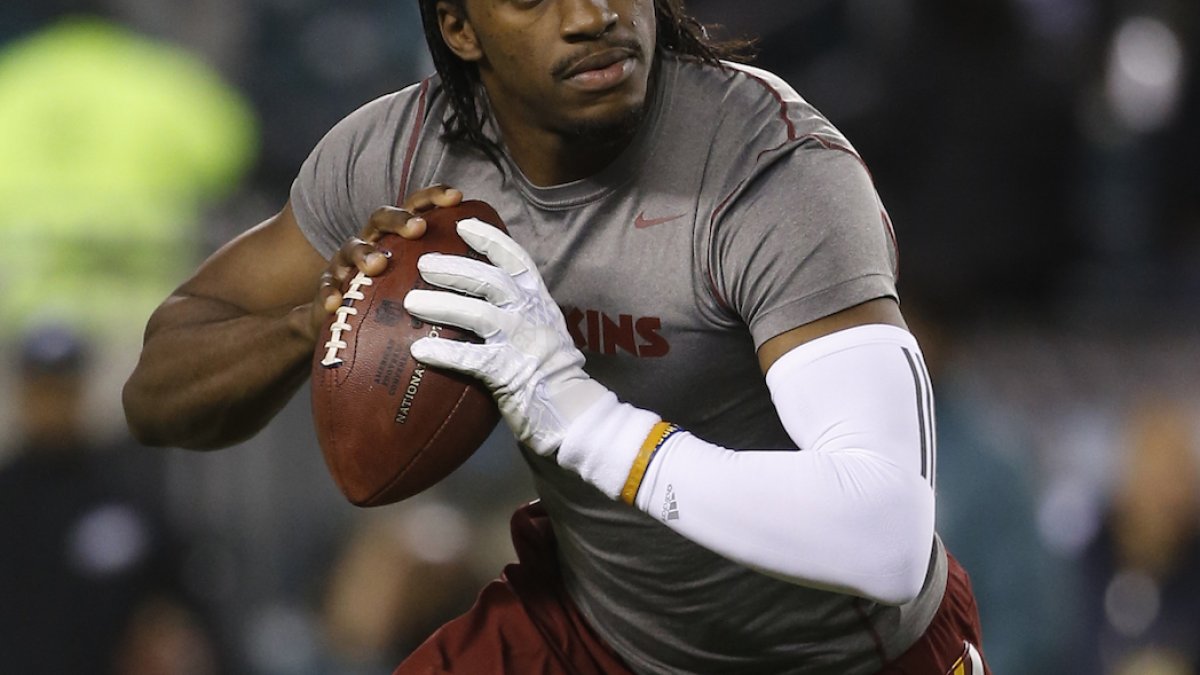Editor’s note: Every weekday in “Daily Focus,” PFF analysts take the latest NFL news and translate what it really means for each team involved.
Why the system is key for RG III: With the launch of ESPN’s new venture, “Undefeated,” RGIII became part of the news cycle again after this excellent piece by Jason Reid chronicled his rise and fall in Washington.
One of the more interesting points the article makes is how the unusual offense structured around Griffin made him so successful initially, and how completely unsuccessful he was in any other system once it had been abandoned.
No team ran play-action more often than Washington did that season, with 39.9 percent of RG III’s dropbacks featuring it—3.8 percent more than any other player. The team in second place was doing a similar thing to help Russell Wilson’s transition in Seattle.
Griffin’s stats were not bad on the plays he wasn’t running play action—as the running threat and effectiveness of the offense overall was still having an impact—but they paled by comparison to those play-action numbers:

Though Griffin was efficient without play-action, throwing 11 touchdowns to just one interception, he was devastating with it, completing 67.7 percent of his passes at 11.8 yards per attempt, and with a passer rating of 116.2 (despite four interceptions on those passes).
Griffin might not like it, but the key to his success in the NFL is working within an offense that suits him, but the same is true for most quarterbacks in the league. If he can put ego aside and the Browns are willing to structure an offense around him that plays to his strengths and masks his weaknesses, RG III can succeed in the NFL, at least in the short-term, despite his limitations as a pure pocket-passer.
If, on the other hand, one of those two things doesn’t happen, we will see more of the guy who played his way to the bench and off of Washington’s roster entirely.
Bosa grows tired of comparisons: In truth, the J.J. Watt comparison never really sat well with Joey Bosa, but the Chargers may be at least one party that sees it as a good one. The team selected Bosa not to play on the edge, but to align—at least on base downs—inside as a 3-4 end, just as Watt does in Houston.
In fact, Watt might be the perfect playing comp for Bosa’s role in San Diego, because as soon as the Texans come out of base, Watt becomes more of an edge rusher, lining up outside of the tackle and attacking with speed on the perimeter rather than up the middle. For those wondering if Bosa is really best-suited inside, the Texans have shown with Watt that he won’t necessarily have to do it more than around one-third of his snaps. Houston only ran base 3-4 on 37 percent of their snaps in 2015, and San Diego was even lower than that, at 33 percent. In fact, the Chargers’ “base” defense is actually a 2-4-5 nickel formation, with 2-3-6 dime defense accounting for another large block of their snaps. Between those two personnel groupings, the Chargers have 72 percent of their defensive snaps in just two sub-package groups, so where Bosa fits in those groups will define him as a player more than where he fits in their 3-4.
All of this is still very much projection, because while he flashed the ability to move around at Ohio State, he rarely did. Of 692 snaps last season he only played inside at DT on 20 of them.
Maybe Bosa isn’t Watt, but in terms of deployment and role as a player, it might just be the perfect comp for the Chargers' rookie.
Deadline for Fitzpatrick-Jets deal: According to Ian Rapoport of NFL.com, May 24 is the “first legitimate deadline” for quarterback Ryan Fitzpatrick and the New York Jets to strike a deal. The Jets have invested significantly in the position by drafting Christian Hackenberg in the second round, and they still have Geno Smith waiting in the wings, as well as last year’s third-rounder, Bryce Petty, on the roster. However, there is little doubt that Fitzpatrick gives them the best chance to win games in the short-term.
The issue for the Jets is that, like Denver, they have a hard cap on the value a mediocre quarterback has, and refuse to go above that just because the market is trending that way. For Denver, it caused them to lose Brock Osweiler as the Texans shipped all of the money they had in his direction, but New York seems to have some leverage in the case of Fitzpatrick, because he is unable to find a similar suitor.
It’s certainly a tough argument to make that Fitzpatrick is an excellent QB who deserves a monster contract—he was the 30th-ranked QB at PFF last season—but there is a case to be made that he suits the Jets well, and does bring something that most passers won’t.
Fitzpatrick will put the ball in the air more than most, whether his receiver is covered or not. In abstract terms, that’s not really a good thing, since throwing into good coverage can lead to all kinds of bad things happening, but when you have receivers like Brandon Marshall, it means those players get more chances to make plays than they would ordinarily have. Fitzpatrick’s particular brand of “YOLO” passes suit the Jets' offense perfectly, and leads to plays like this happening when no other quarterback would even attempt such a pass after the release Marshall gets off the line.



 © 2024 PFF - all rights reserved.
© 2024 PFF - all rights reserved.